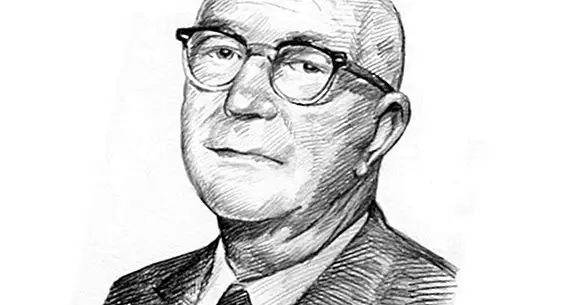Gordon Allport's personality theory
Throughout history, the set of characteristics that make people different from each other, having a distinctive way of interpreting, acting and living the life have been thoroughly studied. This distinctive pattern is what we commonly know as personality. Being an abstract concept, the personality is interpretable from a large number of approaches .
Among these approaches, some consider that personality is a unique configuration in each person, there being no two alike. Thus, each person is totally unique, although some similarities can be found with others. This point of view is what we consider idiographic approach, being the maximum exponent of this Gordon Allport and his theory of personality.
- Related article: "Types of psychological tests: their functions and characteristics"
What makes us do what we do?
The fact that we behave, or that we respond to the world in one way or another is due to a wide group of variables and factors.
The situations we live in, what they demand of us and how we interpret both the situation and what we may be able to see are very relevant elements when deciding on an action plan or another. However, not only does the situation control the behavior, but also there are a series of internal variables that govern together with the environmental demands that we make and we even think concretely .
The latter correspond to the set of characteristics that make up our personality, which according to the principle of functional autonomy of the motives, is a force that causes us to motivate us to act in a certain way, this motivating action being in turn due to the activation of the patterns learned throughout the life cycle.
- Maybe you're interested: "The 15 best sentences of Gordon Allport"
The Propium and its configuration in the personality
The personality has been conceptualized in very different ways according to the author, theoretical current and approach that has treated it. In the case of Allport, this important psychologist considers that the personality is a dynamic organization of the psychophysiological systems that determine the way of thinking and acting characteristic of the subject. Through these elements, Allport creates a theoretical system oriented to explain what is the style of behavior of individuals.
However, the personality needs a structuring element in which the different characteristics of the personality are structured. This axis is what the author calls propium, this being the self-perception of being a differentiated entity. It is about the perception of the subject of himself as being integrated by different characteristics, experiences and desires, being the self-perception of being a differentiated being.
In Allport's theory of personality, it is considered that this perception of the entity itself is formed by different factors . The elements that make up this skeleton of mental life, which are acquired throughout the psychic maturation, are the following.
1. I corporal
This part of the propium is basically the experience of bodily and perceptive sensations , that allow the experience with the external environment. It is the component of consciousness about the parts of one's body and the way in which it feels when it comes into contact with external stimuli.
2. Identity
It is about the idea that we are a "something" in a continuous way, that is living different experiences throughout life. It can be understood as the backbone of our own life history, the way in which we interpret the journey we have made and, from this, the conclusions we draw about ourselves.
3. Self-esteem
The perception that we are not passive entities, but that we modify our experience and our life with our performance, is a very important part when integrating the personality. We see ourselves as valuable beings.
- Related article: "10 keys to increase your self-esteem in 30 days"
4. Self-image
It is a comparative element, which takes into account on the one hand the performance itself and on the other the reaction of the medium before it. In other words, it is what others think of themselves.
5. Extension of the self
This part of the self refers to the perception that the person has concrete interests, these being important elements for us. These objectives and goals form a vector of action that guides the behavior.
6. Rationality
Self-perception of the ability to find adaptive solutions to the different problems and demands that the environment can provide. It is closely related to self-confidence.
7. Intentionality
The most complex element of the propium, the creation of an intentional self, presupposes the self-awareness of being a being with its own objectives and goals, the ability to motivate oneself and strive to achieve
The structure of personality
Personality is an element that can be understood as a kind of organized system that generates behavioral patterns based on the activity of the subject. To explain your organization and allow the study and prediction of behavior, it is necessary to take into account the main and most basic of the elements that configure it: the features.
The traits are that element that allows us to evaluate different stimuli as a set to which we can respond in a similar way, our behavior being in some way adaptive to them.
The features are understood as the point of union between mental processes and physiological components, this union being responsible for our performance. A) Yes, Allport states that the traits cause the tendency to always act in a similar way .
The traits in Allport's personalistic theory
As the main exponent of the idiographic approach, Allport considered that the behavioral patterns of each person are unique and different between subjects. In spite of that, it is considered that human beings have in general the same types of traits, such as dependence, aggressiveness, sociability and anxiety, so it is not uncommon for similar patterns to exist. What makes each individual have his own personality is the relationship that occurs between personality traits and those that stand out in each one.
Personality traits can be classified according to the identification of the general behavior of the subject , considering the author three major types of features
1. Cardinal features
Cardinal features are considered those personality traits that are part of the person's own core , affecting and defining most of the person's behavioral repertoire. That is, they are those that have more weight in the way of being of each individual.
2. Central features
The central features are those sets of characteristics that have an influence on the behavior of the person in different contexts . They participate in our performance and the tendencies that we have even though they influence a more restricted set of behavior, such as socialization, being generally independent among them.
3. Secondary features
It is about some elements that, although they are not part of the general personality of the subjects, they may arise at certain times , as when dealing with a specific situation.
All this set of factors makes the theory of Allport a complex element that tries to give a sense to the personality from a structural point of view, being the main characteristics of personalistic theory the fact that each person is configured through a composition of different traits unique in each person and the fact that the human being is an entity that is not limited to remain static while life passes, but actively participates in its environment to build, experiment and meet goals and objectives.
What kind of theory is Allport?
Allport's theory of personality is interesting not only because of its content, but also because of the confluence between different ideologies and theoretical perspectives.
Regardless of whether it is limited to an idiographic point of view, which highlights the variables that make each person unique and different, The theory established by Allport indicates that although the configuration of each person is unique there are common behavior patterns , because personality traits are in general innate elements shared.
In the same way, although his theory is of an innatist nature, he does not ignore the influence of situational factors when explaining behavior, so he approaches interactionist positions that see behavior as a combination between biological and environmental.
Finally, Allport's theory is part of the structuralist theories of personality. These theories are based on the idea that the personality is a configuration of characteristics organized with a concrete structure, which allows predicting future behavior as the individual tends to act according to said structure.
However, it also shows a certain interest in the process, that is, in the process by which it is developed and not only its structure, in analyzing how the propium is being formed.
Bibliographic references:
- Allport, G.W. (1961). Pattern and Growth in personality. New York: Holt.
- Bermúdez, J. (1996). Personal theory of G.W. Allport. In Bermúdez, J. (Ed.) Psychology of the personality. Madrid: UNED.
- Hernangómez, L. & Fernández, C. (2012). Psychology of Personality and Differential. CEDE Preparation Manual PIr, 07. CEDE: Madrid.



















